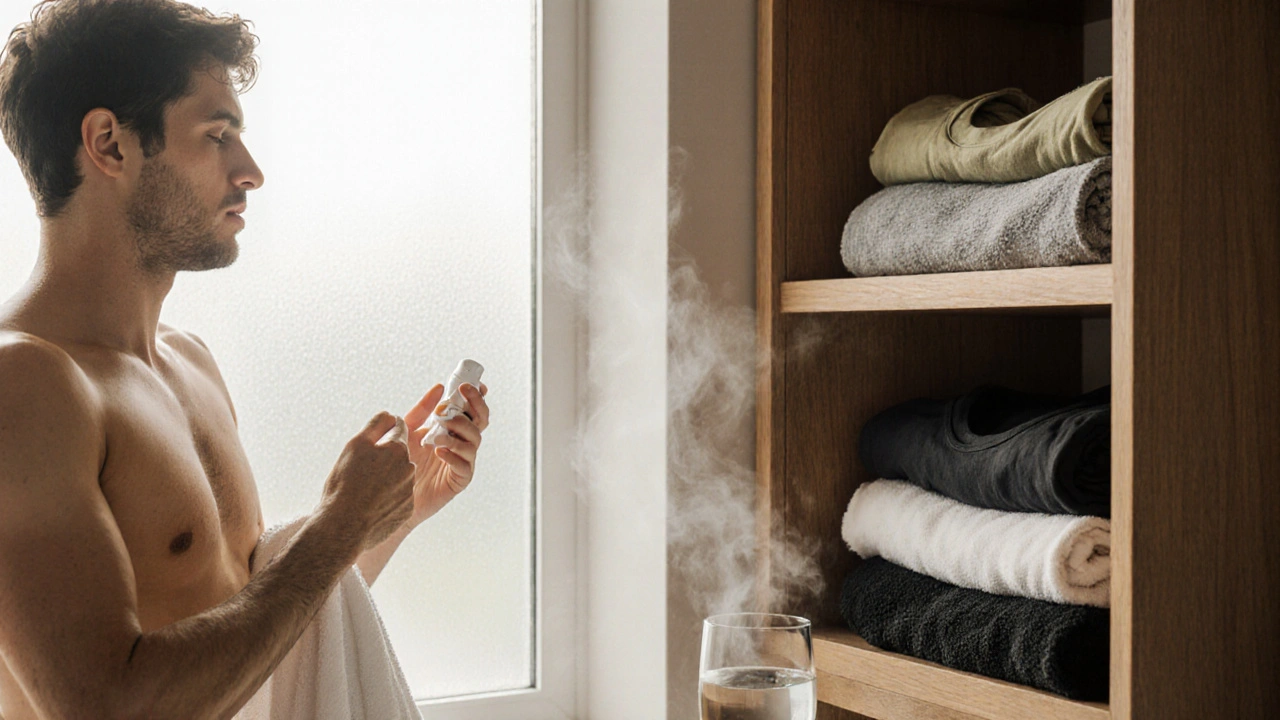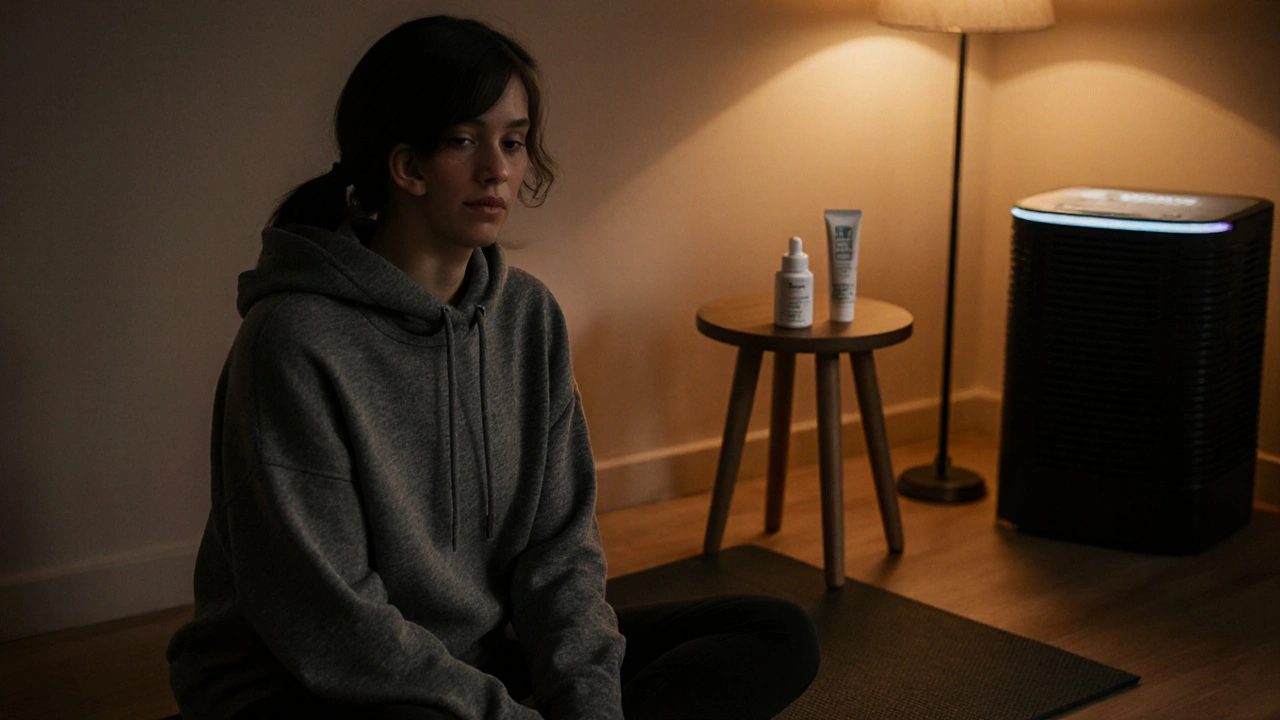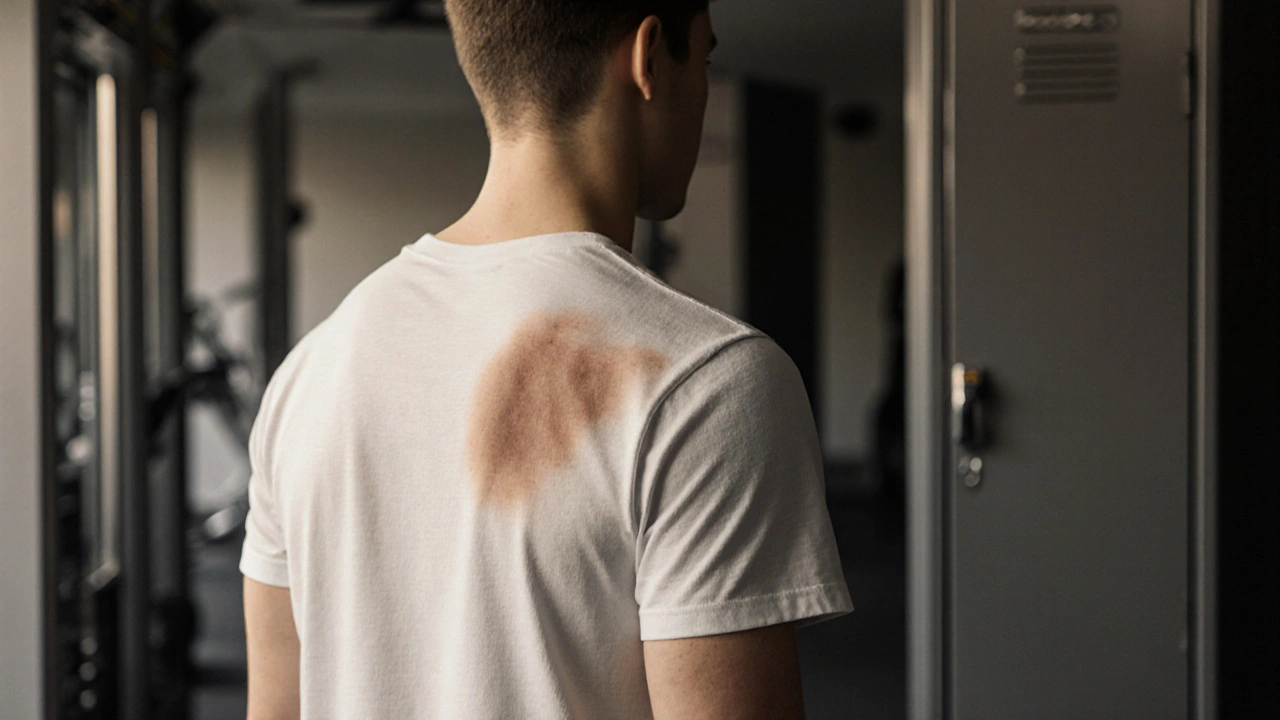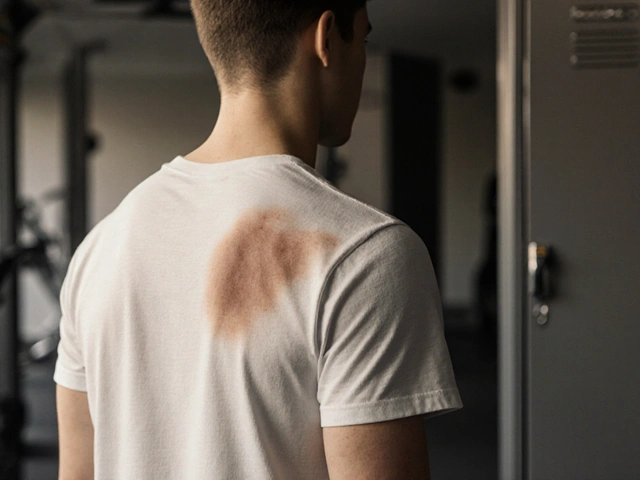Tinea Versicolor Workout Suitability Calculator
Your Tinea Versicolor Exercise Plan
This tool helps you assess how suitable different exercise types are based on your current conditions. Enter your details below to get personalized recommendations.
Recommended Exercise Types
Low-Impact Cardio
Highly suitable for your conditions. Activities like brisk walking, light cycling, or elliptical training keep heart rate up without excessive sweating.
Strength Training
Recommended with modifications. Lift moderate weights with longer rest periods. Avoid high-intensity interval training (HIIT).
Yoga and Pilates
Excellent choice. Gentle flow sessions often happen in cooler studios and allow you to wipe sweat off between poses.
Avoid Prolonged Sauna-Style Workouts
Not recommended for your current conditions. Saunas, hot yoga, and intense boot-camp classes create humid environments that can trigger the fungus.
Living with Tinea Versicolor is a fungal skin condition that loves warm, oily environments. It shows up as light‑or‑dark patches, especially on the back, chest, and shoulders. The good news? You don’t have to quit the gym or ditch your weekend runs. With a few adjustments, you can keep moving while keeping the skin calm.
tinea versicolorQuick Takeaways
- Choose breathable fabrics like cotton or moisture‑wicking blends to reduce sweat buildup.
- Schedule workouts during cooler parts of the day and shower within 30 minutes after exercising.
- Maintain a regular antifungal regimen prescribed by a dermatologist.
- Stay hydrated and watch humidity levels; high moisture fuels the fungus.
- Monitor any new patches and seek professional advice if they spread rapidly.
What Is Tinea Versicolor?
At its core, Tinea Versicolor is caused by an overgrowth of Malassezia, a type of yeast that lives on normal skin. Under the right conditions-heat, humidity, excess oil-the yeast multiplies and interferes with melanin production, creating those uneven patches.
Typical triggers include summer heat, oily skin products, and prolonged sweating. Most people see improvement with topical antifungal creams or oral medication, but lifestyle tweaks can speed recovery and prevent flare‑ups.
How Exercise Impacts the Condition
Physical activity itself isn’t harmful, but the by‑products of a workout-sweat, warmth, and friction-create a perfect breeding ground for the yeast. When sweat stays on the skin for too long, the moisture clings to the upper layers, allowing Malassezia to thrive.
Additionally, tight clothing can trap heat and oils, especially around the torso where most patches appear. Understanding this link helps you pick smarter workout habits instead of avoiding exercise altogether.

Preparing for a Workout
Planning ahead reduces the risk of a flare‑up. Follow these steps before you hit the treadmill or yoga mat:
- Dress wisely. Opt for loose‑fitting, breathable fabrics. Natural fibers like cotton and bamboo, or technical moisture‑wicking blends, pull sweat away from the skin.
- Keep the skin clean. Shower with a gentle, non‑comedogenic cleanser at least 30 minutes before exercise so that excess oil is removed.
- Apply a light barrier. Some dermatologists recommend a thin layer of non‑greasy moisturizer to reduce friction. Choose a product labeled “non‑comedogenic” and free of heavy fragrances.
- Time it right. Early mornings or late evenings are cooler, lowering sweat volume. If you can, avoid the hottest part of the day.
- Hydrate well. Drinking water helps regulate body temperature, which can lower sweating intensity.
Choosing the Right Exercise Types
Not all workouts are created equal when it comes to skin health. Here’s a quick guide:
- Low‑impact cardio - Activities like brisk walking, light cycling, or elliptical training keep heart rate up without excessive sweating.
- Strength training - Lift moderate weights with longer rest periods. This reduces overall perspiration compared to high‑intensity interval training (HIIT).
- Yoga and Pilates - Gentle flow sessions often happen in cooler studios and allow you to wipe sweat off between poses.
- Avoid prolonged sauna‑style workouts - Saunas, hot yoga, and intense boot‑camp classes create a humid environment that can trigger the fungus.
Switching up your routine prevents boredom and lets you find a sweet spot where you stay fit without aggravating the skin.
Post‑Workout Care
The minutes after you finish moving are crucial. Follow this routine:
- Shower promptly. Aim for within 30 minutes. Use lukewarm water and a mild cleanser; hot water can strip natural oils and worsen dryness.
- Dry thoroughly. Pat the skin with a clean towel, especially in folds and behind the ears where moisture lingers.
- Apply prescribed medication. If you’re on a topical antifungal cream, do so after the skin is dry. Follow your dermatologist’s schedule-usually once or twice daily.
- Choose the right post‑workout clothes. Switch to a fresh, dry outfit. Fabric should still be breathable; avoid synthetic socks that trap sweat.
- Moisturize if needed. If your skin feels tight, use a lightweight, oil‑free moisturizer that won’t feed the yeast.
Managing Flare‑Ups
Even with perfect habits, occasional flare‑ups happen. Here’s how to handle them without panicking:
- Increase antifungal frequency. Talk to your dermatologist about a short‑term boost in treatment.
- Limit exposure to humidity. Use a dehumidifier at home during rainy seasons and avoid overly humid gyms.
- Swap footwear. Shoes that don’t breathe can trap sweat on the feet, potentially spreading the yeast to the torso via socks.
- Use a Wood's lamp check. A Wood's lamp exam highlights the affected areas under UV light, helping you track progress.
- Stay consistent. Skipping medication for a few days often leads to rebound growth.

When to See a Dermatologist
If you notice any of the following, book an appointment:
- Rapid spread of patches across new body areas.
- Intense itching or burning sensations.
- No improvement after two weeks of over‑the‑counter treatment.
- Recurring flare‑ups despite good hygiene and medication.
Professional care may involve oral antifungals, stronger topical agents, or a customized skincare regimen.
Clothing Fabric Comparison
| Fabric | Breathability | Moisture‑wicking | Best For |
|---|---|---|---|
| Cotton | High | Low | Low‑intensity activities, cooler climates |
| Bamboo | High | Medium | Yoga, pilates, casual walks |
| Polyester‑blend (moisture‑wicking) | Medium | High | Running, cycling, high‑intensity workouts |
| Wool (Merino) | Medium | Medium | Outdoor activities in variable weather |
| Nylon | Low | Medium | Specialty compression gear (use sparingly) |
Key Takeaways for a Balanced Routine
Staying active while managing Tinea Versicolor boils down to three pillars: smart clothing, timely hygiene, and consistent treatment. By weaving these habits into your workout schedule, you’ll protect your skin without sacrificing the benefits of exercise.
Frequently Asked Questions
Can I still do high‑intensity interval training (HIIT) with tinea versicolor?
Yes, but you’ll need extra precautions. Choose moisture‑wicking gear, keep the session under 20 minutes, and shower immediately afterward. If you notice new patches, cut back on intensity until the skin stabilizes.
Do antifungal shampoos help on the body?
Many dermatologists recommend using an antifungal shampoo as a body wash a few times a week. The active ingredients, like ketoconazole, can reduce yeast on the skin without harsh chemicals.
Is it okay to skip medication on weekends?
Skipping doses can let the fungus rebound, especially if you’re already sweating a lot during weekend sports. Stick to the prescribed schedule even on days off.
What humidity level should I aim for at home?
Aim for 40‑60% relative humidity. A simple hygrometer can help you monitor, and a dehumidifier works well in damp seasons.
Can sunscreen cause flare‑ups?
Some sunscreens contain oil‑based ingredients that feed the yeast. Look for “oil‑free” or “non‑comedogenic” formulas and test a small area first.



Comments
Reading through this guide on Tinea Versicolor and exercise reminded me how often we overlook the subtle ways our daily habits can exacerbate a fungal condition, especially when we think the problem is merely cosmetic. The author correctly emphasizes breathable fabrics, but it’s worth noting that even high‑quality moisture‑wicking synthetics can trap heat against the skin if they fit too tightly. In addition, the timing of workouts plays a crucial role; exercising during the cooler early morning hours reduces sweat accumulation, which is a key trigger for Malassezia overgrowth. The recommendation to shower within 30 minutes is spot on, yet many gym‑goers forget to use a mild, non‑comedogenic cleanser, opting instead for fragranced body washes that can feed the yeast. Moreover, the post’s advice on using a light, non‑greasy moisturizer is sound, but applying too much can create a film that hinders evaporation, counteracting the benefits of moisture‑wicking clothing. The table comparing fabrics is useful, especially the distinction between cotton’s high breathability but low wicking and polyester blends’ high wicking capacity; however, the latter should be chosen only if the fit allows airflow. Another point worth stressing is the importance of personal hygiene accessories such as towels; using a fresh towel after each workout prevents cross‑contamination. The section on post‑workout care correctly highlights drying folds and behind the ears, which are often missed spots where moisture lingers. Additionally, the usage of antifungal shampoos as body washes can be an effective adjunct therapy, a tip that many patients overlook. It is also advisable to keep gym equipment clean; wiping down machines after use reduces the risk of re‑colonization from shared surfaces. The article’s reminder to monitor humidity levels at home, aiming for 40‑60%, aligns with dermatological best practices. While the guide discourages high‑intensity interval training, it could further note that short bursts of HIIT combined with ample rest periods may be tolerable if followed by immediate cleansing. The recommendation to avoid sauna‑style workouts is critical, yet some readers might benefit from knowing that occasional steam rooms, if limited to a few minutes, are less likely to cause flare‑ups than extended sessions. Finally, the emphasis on consistent medication adherence cannot be overstated; skipping doses, even on “off” days, can lead to rebound growth. Overall, this comprehensive article blends practical advice with scientific rationale, making it a valuable resource for anyone navigating fitness with Tinea Versicolor.
Wow, that was a marathon of info! I love the tip about using a fresh towel – totally missed that before.
Also, a quick reminder: not all "moisture‑wicking" tees are created equal, watch for tight fits.
Great rundown, especially the part about keeping humidity between 40‑60%. I’d add that a cheap hygrometer can be bought for less than $10 and makes tracking easy. Also, consider swapping out socks daily; feet can be a hidden source of yeast. Lastly, remember that some sunscreen formulas are oil‑based and might worsen the condition – look for non‑comedogenic options.
Honestly, you’re missing the drama of gym lockers! They’re breeding grounds for fungus. If you can’t avoid them, spray a quick antifungal wipe on the bench before you sit down. Also, wearing a compression shirt that doesn’t breathe? Total nightmare. Trust me, I’ve learned the hard way.
Nice guide! The sarcastic touch about “just ditch the gym” made me smile. Realistically, a quick 20‑minute jog in the evening is a win‑win – you get cardio without the scorching heat. Plus, swapping cotton for a bamboo blend gives that soft feel without sacrificing breathability.
Thanks! I’ve actually tried a 30‑minute bike session at dawn and felt great – no extra sweat patches. The key is drying off quickly and changing into dry clothes right after.
From a philosophical angle, this isn’t just about skin health; it’s about listening to the body’s signals. When we push through discomfort, we often ignore early warnings like excess moisture. Embracing mindful movement – being aware of breath, temperature, and sweat – transforms exercise into a healing practice rather than a punitive one.
Indeed, mindful movement is essential. To elaborate, I recommend a pre‑workout ritual: a brief warm‑up of dynamic stretches followed by a 5‑minute meditation focusing on bodily sensations. This not only reduces cortisol spikes but also prepares the skin’s micro‑circulation, aiding sweat evaporation. Pair this with a breathable, medium‑weight polyester blend that channels moisture away without feeling clingy.
Great post! 😃 I always keep a spare set of moisture‑wicking shirts in my gym bag – saves me from those post‑workout sweat patches.
While extra shirts are useful, it’s worth noting that constantly changing clothes can introduce more friction, potentially irritating already sensitive skin. Balance is key.
Excellent advice.
I love how this article encourages consistency with medication – skipping doses is a common pitfall that many overlook.
This guide beautifully blends science and cultural awareness; the mention of bamboo fabrics highlights eco‑friendly options.
Yo, I’m from India and humidity here is insane. Running at night when it’s cooler really helps, and using a cheap dehumidifier at home makes a huge diff.
Excellent points! I’d add that a simple routine of checking skin after each workout can catch early signs before they spread. Also, opting for a quick‑dry towel reduces lingering moisture.
Stick to short, moderate sessions and shower quickly.
Very insightful! 😊 Remember, the mind‑body connection matters – a relaxed mindset can lower sweat production. Also, a quick post‑workout stretch keeps circulation smooth, aiding skin recovery.